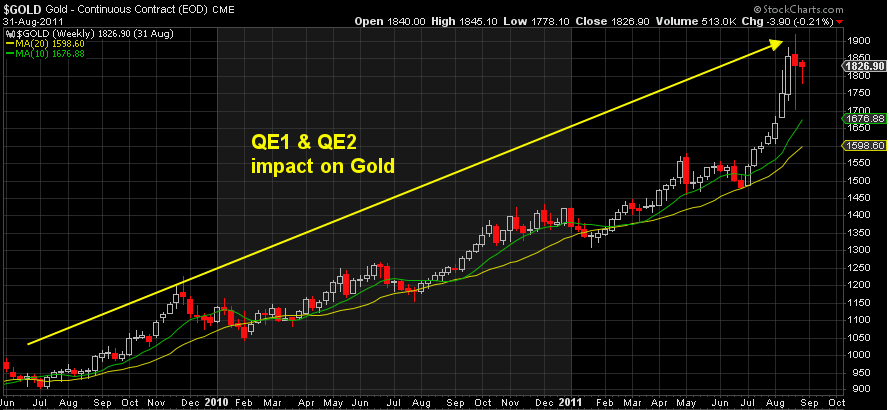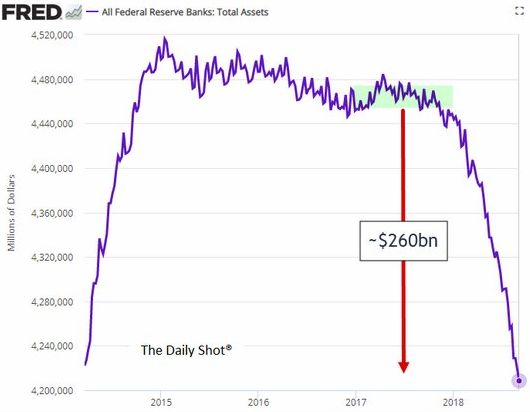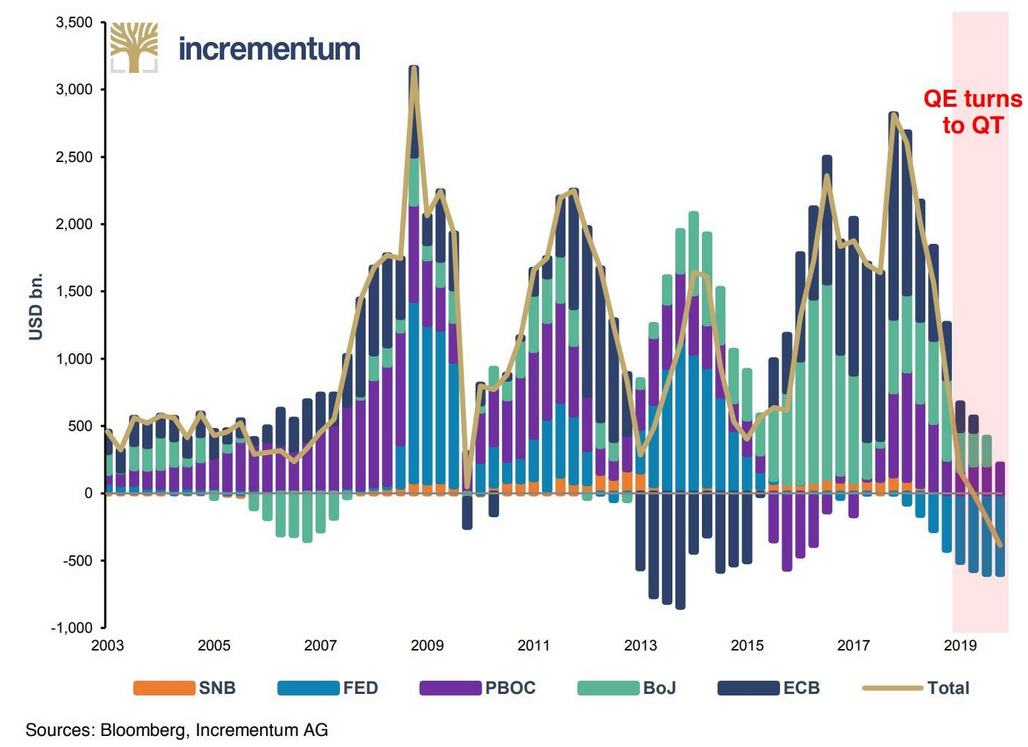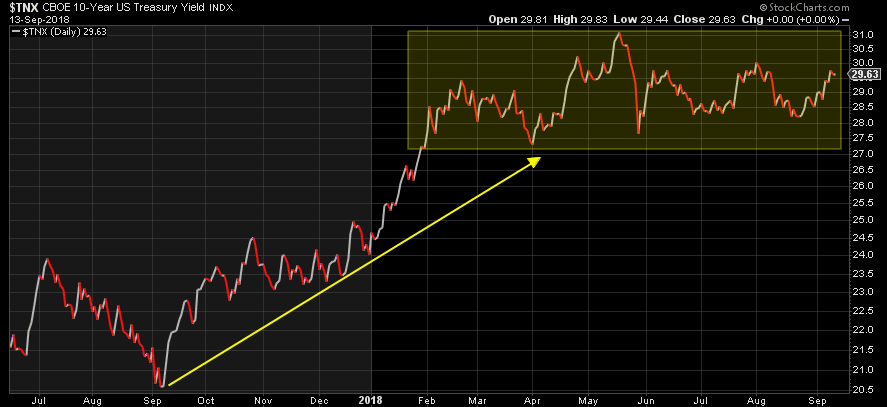While we wait for news on the 25% tariffs on $200bln or 40% of Chinese exports to the U.S.—and with the threat of the same on the remaining ~$300bln to follow—I want to outline the endgame for the dollar and the likely beginning of the explosive rally for Gold.
Simply put: When the U.S. stock market crashes, buy Gold.
To be more specific: when the S&P 500 has fallen 20-30%, buy Gold, in my opinion, because the ‘Fed Put’ will soon be exercised at that point. The Fed will reverse policy to stimulus on steroids. The dollar rallied from April 2008 and peaked in March 2009, when stocks bottomed out—the same time the Fed announced QE, or QE1 as we now know it. Then the dollar fell. It is not unreasonable to expect the same to happen this time around. Gold bottomed out in October 2008, as stocks plummeted and then soared 280% to greater than 1900 over the next three years, as QE1 and QE2 were underway.

The coming crash in the U.S. stock market is the catalyst for the Fed’s reversal in policy, so why do I expect a crash?
Quantitative Tightening and Budget Deficits
Lee Adler pointed out several weeks ago that as the budget deficit soars, Treasury bond issuance is increasing by around $100bln per month. At the same time, the Fed is increasing its balance sheet reduction, or “QT” program, to $50bln a month in October, a run-rate of $600bln per year. That means $150bln of additional demand for U.S. Treasuries is required every month.

To make matters worse, foreign central banks are buying fewer Treasuries. So, more supply and less demand typically means lower prices and higher yields, hence the Fed will be forced to intervene in October or shortly thereafter with QE again to fill the demand gap. But they need an excuse to reverse policy. A stock market crash would provide that excuse.
The Global Punchbowl is Being Removed
Ron Stoeferle provides excellent information on Gold but, more importantly, on global central bank liquidity, which is expected to turn negative in Q4 this year or Q1 next due to the Fed’s QT and the ECB’s plan to taper its QE to zero at the end of this year.

In my opinion, the only reason stock prices have risen since the 2008 financial crisis is global liquidity stimulus in the form of central bank money printing or QE. With the punchbowl removed, like any Ponzi scheme, stocks will collapse—bonds, too—unless the central banks all reverse course to QE on steroids.
The Fed is focused on three priorities in this order: Stocks, Bonds and the Dollar.
U.S. equities represent 150% of U.S. GDP. Federal tax receipts are heavily reliant on taxes from capital gains, IRA distributions and consumption driven by wealth created at top of the food chain, the 1% who are heavily invested in stocks. This makes the stock market critical to U.S. government finances and the perception of solvency. Without a rising stock market, Federal tax receipts fall and the budget deficit increases. This makes matters much worse when budget deficits are already ballooning due to tax cuts and higher spending.
At the same time, the Fed can’t allow bond yields to rise dramatically, as that would sink all risk assets (most notably the housing market) and balloon the Treasury’s debt interest costs and, again, the budget deficit.
With respect to the dollar, back in Q4 2017, the Fed noticed that a weaker dollar pushed bond yields higher. This was at a time when Treasury bond issuance was soaring due to the rapidly rising budget deficit, and the Fed had begun reducing its balance sheet, so-called “QT. Who wants to buy U.S. Treasuries if their prices are falling as yields rise AND the dollar is falling in foreign currency terms also? So in February this year, the Fed began supporting a stronger dollar. Ten-year Bond yields have remained capped at around 3% ever since.

But the stronger dollar is now creating enormous stress on emerging markets that have borrowed heavily in dollars, and it risks global contagion that could spread to banks worldwide. We have already seen the emerging market currencies plummet in recent months, most notably those of Argentina and Turkey. The IMF has already provided loans to Argentina to limit international banks’ losses on their debt investments.
A stronger dollar also weighs on the dollar value of foreign earnings for U.S. multinationals, undermining their earnings per share.
None of this is good for the stock market. The S&P has struggled since February, due in part to the Fed’s rate hikes and QT policy, as well as the strength of the dollar. The only reason why the S&P has not fallen further is the record level of stock buybacks, aided by Trump’s corporate tax cuts this year. But their effect runs out at the end of the year.
Yet despite the stress rate hikes, QT and dollar strength put on the stocks, Fed Chair Powell is likely to continue the Fed’s tightening policies until something breaks, and that is likely to be the stock market. His comments, despite the growing problems in emerging markets, reflect this.
When the stock market crashes, the Fed faces what Luke Gromen and Louis Curran termed “The Fed’s Trilemma”. The U.S. central bank will have to choose to sacrifice one of their priorities: the stock market, the bond market or the dollar. Well, given the potentially disastrous effects of a protracted stock market meltdown and, moreover, a Treasury bond market collapse, they will obviously sacrifice the dollar.
This is why I believe the Fed will be forced to revert to monetary insanity on steroids following the stock market crash to come: in order to pump stocks even higher and keep bond yields down. Otherwise the entire U.S. Ponzi scheme collapses. In order to do this, they will have to sacrifice the dollar.
If there was any doubt that the Fed plans to do this, it was erased recently. The FOMC minutes in August led with the Fed’s plans to address the next crisis. During his Jackson Hole address two days later, Fed Chair Powell said he would do “whatever it takes” in such an event. If that weren’t enough, Hank Paulson, Ben Bernanke, and Tim Geithner wrote an Op-Ed in the New York Times this week that basically called for emergency powers to bail out every financial institution should such a crisis occur. It’s obvious that they plan to ride to the rescue yet again. Why else would they so frequently—and all of a sudden—talk about plans to address a crisis?
Not to mention the fact that over the past several months, almost every member of the Fed has been at pains to say each and every aspect of Trump’s policies (Trade, Foreign, Fiscal, Immigration, Regulatory) could lead to another financial crisis. Why are they all repeatedly saying this, unless they expect such a crisis soon and are preparing to blame Trump in order to divert it from the true culprits: themselves. If you didn’t already know, the Fed apparently never makes mistakes. Never. They cover their tracks well.
Trade War
I’ll keep this brief, because I’ve covered it extensively in previous articles. The trade war could bring down the U.S. stock market in so many ways. It could further hit emerging market economies and cause global contagion and recession. China could further devalue the yuan—we saw what happened when they devalued the yuan by just 3% in August 2015. China could sell Treasuries or announce their true, and massively understated, Gold holdings. Tariffs could impact American companies’ costs and, therefore, their earnings. They could also cause a spike in consumer inflation and higher interest rates and yields, hurting consumer spending and increasing consumer debt defaults.
The U.S. stock market is exposed in so many ways to the trade war between the U.S. and China—and much of the rest of the world, it seems. But make no mistake, this would just be the catalyst for a stock market crash, not the true cause. That lies with the Fed and its policies, in my opinion.
There are plenty of other signals out there that a crash is coming, but I’ll finish with one. The Banks are still near record long U.S. Treasury Bond futures. The Commercials are the so-called smart money for a reason. If they are record long, it is because they expect yields to fall. What could cause yields to fall precipitously? A stock market crash, followed by a return to Quantitative Easing #4?

In conclusion, this article is directly related to the prospects for Gold in the near future, because a stock market crash will trigger a Fed reversal in policy to “monetary insanity on steroids” and a peak in the dollar. This will be tremendously bullish for Gold, other precious metals, commodities, bonds and stocks. Everything will go up… except the dollar.
Do you still wonder why China and Russia are loading up on physical Gold? Follow the smart money.
